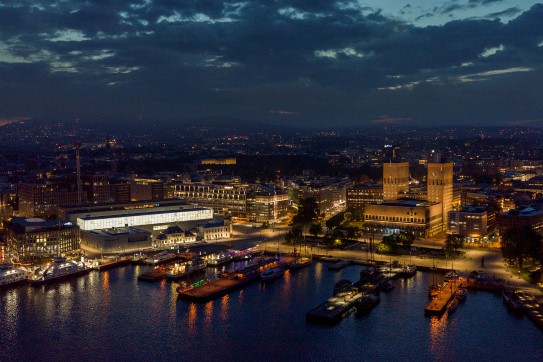The Museum and the City

Transcription
Narrator:
In the spring of 2008, the Norwegian government decided that the new National Museum should be located on the old Vestbanen railway station site, on the edge of the square outside City Hall.
The site would become a collective home for four different collections that had previously belonged to different museums — the National Gallery, the Museum of Contemporary Art, the Museum of Decorative Arts and Design, and part of the Museum of Architecture.
The journey to this decision was long. It had been difficult to find a site that could accommodate four large museums under one roof.
Each museum with its diverse collections had different needs, while at the same time, the museum wouldn’t be solely a home for art. It also needed to accommodate a library, educational facilities, shops and eating places – as well as offices, workshops and large areas for the storage and conservation of artworks.
The new museum was also intended to be an open, welcoming space, where people could attend concerts and lectures. It had to be a living museum with an active role in the city’s life. For that reason, the location was very important:
Klaus Schuwerk:
The urban situation is actually the most interesting in Norway; it’s one of the most urban places, and it’s where many people come together. The ships are arriving, the people from Aker Brygge, and the tram is stopping.
Narrator:
This is Klaus Schuwerk, head architect at the German firm Kleihues + Schuwerk, which won the international architectural competition in November 2010.
Klaus Schuwerk:
On the other side is Akerhus festning, and then the whole panorama opens towards the sea and the islands, so it’s an extremely exciting urban situation.
Narrator:
Klaus Schuwerk considered Akershus Fortress and City Hall to be important architectural reference points. Among other things, he wanted the sea-facing square outside the museum, that we call Museum Square, to complete the square outside City Hall.
Talette Rørvik Simonsen:
It’s important to notice the height of the museum – it’s actually quite low. So it integrates itself into the urban space that it’s now part of. So we could say that it submits itself to City Hall. And it also functions together with the fortress and City Hall to make what’s almost a kind of triangle of buildings with a square around them.
Narrator:
Talette Rørvik Simonsen is head of research and development at the National Museum.
Talette Rørvik Simonsen:
For Schuwerk, it’s also an important thing – and something that he’s repeated in several interviews, that at the same time as the Museum will create a connection between the fortress and the City Hall, both of which are important historical landmarks in the city, the National Museum in itself will create its own inner square within the larger City Hall square. We could think of it as a more intimate urban space, perhaps.
Of course, it is pretty much connected with the City Hall square, but it will still be a place to take a break and digest your experiences of the museum after you come outside. And in a way, you can take a moment with a cup of coffee or over lunch to reflect, to think about what you’ve just seen. But it can also quite simply be a place to sit and absorb the urban landscape. The history that this cityscape represents.
Narrator:
The museum site at Vestbanen is surrounded by buildings on all sides, with the exception of the side facing the sea, where there is a tram line. Jon Geir Placht is project director for the National Museum. He tells us about the many challenges posed by the site:
Jon Geir Placht:
It hasn’t been an easy site to build on. There’s the harbour and the sea-level, and there’s the road tunnel running underneath. So we couldn’t do any rock-blasting here. And there are tram lines very close to the building on two sides. And we have protected historic buildings: the Station Master’s House and the Nobel Peace Centre. And then we have the new National Museum. And between them, a beautiful space has been created, Museum Square. We have the fortress on one side, we have the City Hall, and we have the sea. I think we’ve found a fantastic location.